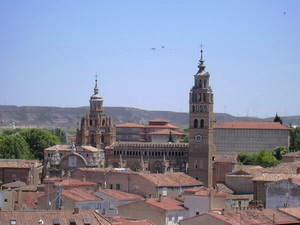Aragón
Travel Guide
Tarazona by Jakob Jelling
Search
for hotels in Tarazona and Surrounding Areas
Tarazona has been called
Mudejar City; it's unique in that the streets are laid out in tiers above
the Queiles River quays. Because it was built at the foot of the Moncayo
Mountain, there was little flat land to build upon anyway. The kings of
Aragon lived here once. The Romans, as in most places in Spain, predated
them. Today you can stroll the medieval streets fronted with tall facades
in the barrios of the town.
 Tarazona's
Gothic cathedral, started in the 12th century and completed in the 16th
century, is its primary attraction. Despite the fact that it was completed
well into the Catholic period of Spain, the Mujedar style is still very
clearly present in the cathedral's belfry and lantern tower. Its dome is
quite similar to that of the Zaragoza cathedral. Tarazona's
Gothic cathedral, started in the 12th century and completed in the 16th
century, is its primary attraction. Despite the fact that it was completed
well into the Catholic period of Spain, the Mujedar style is still very
clearly present in the cathedral's belfry and lantern tower. Its dome is
quite similar to that of the Zaragoza cathedral.
You can also visit the Ayuntamiento,
or Town Hall, with its reliefs of Ferdinand and Isabella as they conquered
Granada together. This monument is on the Plaza de Espana on a hill overlooking
the river, and if you pause here for a few moments, you can experience
its marvelous view. The Ruta Turistica from here will take you to Santa
Magdalena church, which has yet another Mujedar tower; this tower is the
primary landmark of the skyline, and can be seen for miles. The mirador
of the church has a panoramic view. At the top of the hill is La Concepcion,
another tower-blessed church.
Tarazona also, until the
expulsion of the Jews in 1492, had a vibrant Jewish population in the old
part of town. Today, little remains that is recognizable. The alleys are
fronted with Moorish and Spanish buildings, and some, called "hanging houses,"
are built on top of natural rock formations, beneath which are caves once
used by Tarazona's Jewish population. In the center of the old section
of town is a large ruined building with an ornate medieval door that researchers
think once was a Talmud Torah with a mikveh in the basement; a Jewish group
is working right now to fully restore this house and convert it into a
museum devoted to the Jews of Tarazona.
Another particularly interesting
feature of Tarazona is the octagonal bullring, with its walls formed by
houses that are still lived in today.
Where to Stay
The Brujas de Becquer is
a half-mile southeast of Tarazona, on the road to Zaragoza. This hotel
is modern and unpretentious, but it's comfortable and neat and quite adequate
for most, with private showers. In the dining room, you can take advantage
of an excellent fixed-price meal.
Where to Eat
The food of Tarazona is known
for its almost austere plainness; this has been tempered lately by chefs
who have brought an elegance to their cooking. Today, the food is still
simple, but made of the freshest ingredients, and with subtle touches that
give it a sophistication the food of Tarazona never had before.
El Galeon is a good example.
They serve primarily Tarazona food, with their specialties being a simple
stew and custard desert.
Search
for hotels in Tarazona and Surrounding Areas
Top
|

